DESCRIPTION There may be a
short circuit between one of the CAN bus lines and +B when there is no
resistance between terminal 23 (CA1H) of the central gateway ECU
(network gateway ECU) and terminal 16 (BAT) of the DLC3, or terminal 8
(CA1L) of the central gateway ECU (network gateway ECU) and terminal 16
(BAT) of the DLC3. |
Symptom | Trouble Area |
|
*1: w/ Pre-collision System
*2: w/ Blind Spot Monitor System | |
There
is no resistance between terminal 23 (CA1H) of the central gateway ECU
(network gateway ECU) and terminal 16 (BAT) of the DLC3, or terminal 8
(CA1L) of the central gateway ECU (network gateway ECU) and terminal 16
(BAT) of the DLC3. |
- Short to +B in CAN main bus line
- Short to +B in CAN branch line
- Central gateway ECU (network gateway ECU)
- Forward recognition camera*1
- Millimeter wave radar sensor assembly*1
- Blind spot monitor sensor RH*2
- No. 1 CAN junction terminal
- No. 1 CAN junction connector
- No. 2 CAN junction connector
- No. 7 CAN junction connector
| WIRING DIAGRAM
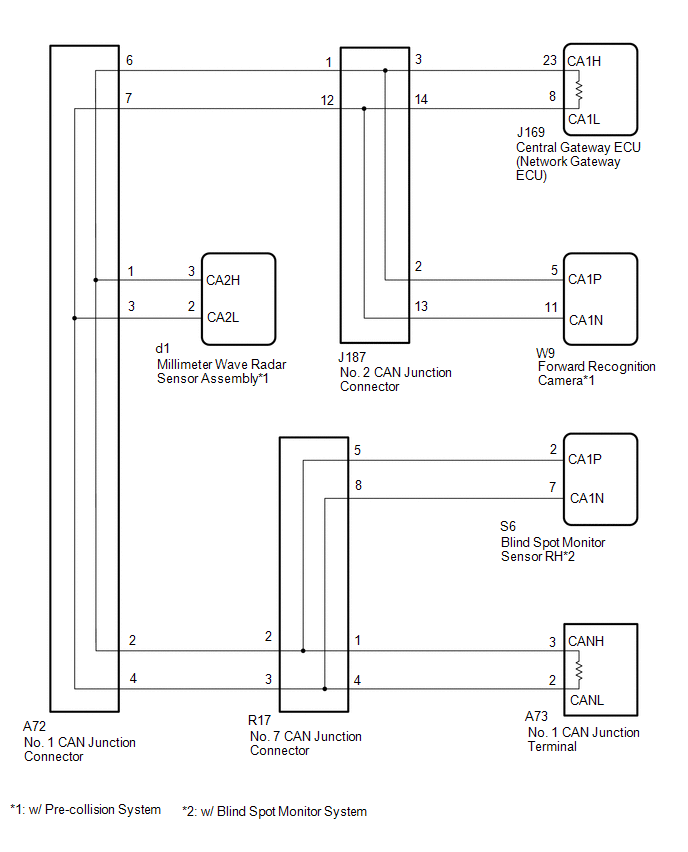 CAUTION / NOTICE / HINT
CAUTION: When performing the confirmation driving pattern, obey all speed limits and traffic laws.
NOTICE:
HINT:
- Before disconnecting related connectors for inspection, push in on each
connector body to check that the connector is not loose or disconnected.
- When a connector is disconnected, check that the terminals and connector body are not cracked, deformed or corroded.
PROCEDURE |
1. | CHECK FOR SHORT TO B+ IN CAN BUS WIRE (NO. 1 CAN JUNCTION CONNECTOR) |
(a) Disconnect the cable from the negative (-) battery terminal.
| (b) Disconnect the No. 1 CAN junction connector. |
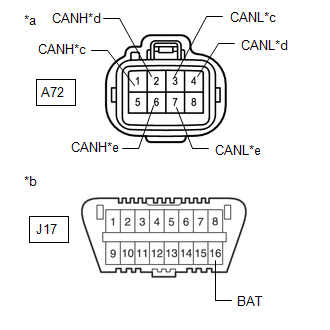 |
|
*a | Front view of wire harness connector
(to No. 1 CAN Junction Connector) | |
*b | Front view of DLC3 | |
*c | to Millimeter Wave Radar Sensor (w/ Pre-collision System) | |
*d | to No. 7 CAN Junction Connector | |
*e | to No. 2 CAN Junction Connector | | |
(c) Measure the resistance according to the value(s) in the table below.
Standard Resistance: |
Tester Connection | Condition |
Specified Condition | Connected to |
|
*: w/ Pre-collision System
| | A72-1 (CANH) - J17-16 (BAT) |
Cable disconnected from negative (-) battery terminal |
6 kΩ or higher |
Millimeter wave radar sensor* | |
A72-3 (CANL) - J17-16 (BAT) | |
A72-2 (CANH) - J17-16 (BAT) |
Cable disconnected from negative (-) battery terminal |
6 kΩ or higher |
No. 7 CAN junction connector | |
A72-4 (CANL) - J17-16 (BAT) | |
A72-6 (CANH) - J17-16 (BAT) |
Cable disconnected from negative (-) battery terminal |
6 kΩ or higher |
No. 2 CAN junction connector | |
A72-7 (CANL) - J17-16 (BAT) |
|
Result | Proceed to | |
OK | A | |
NG (No. 7 CAN junction connector CAN main wire) |
B | | NG (No. 2 CAN junction connector CAN main wire) |
C | | NG (Wire to ECU or sensor) |
D |
| A |
 | REPLACE NO. 1 CAN JUNCTION CONNECTOR |
| C |
 | GO TO STEP 4 |
| D |
 | GO TO STEP 8 |
|
B |
 | |
(a) Reconnect the A72 No. 1 CAN junction connector.
|
NEXT |
 | |
| 3. |
CHECK FOR SHORT TO B+ IN CAN BUS WIRE (NO. 7 CAN JUNCTION CONNECTOR) |
| (a) Disconnect the No. 7 CAN junction connector. |
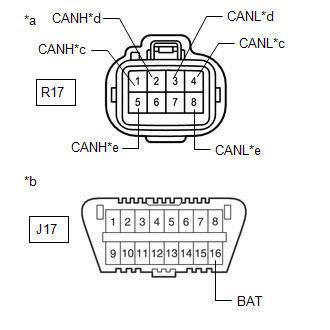 |
|
*a | Front view of wire harness connector
(to No. 7 CAN Junction Connector) | |
*b | Front view of DLC3 | |
*c | to No. 1 CAN Junction Terminal | |
*d | to No. 1 CAN Junction Connector | |
*e | to Blind Spot Monitor Sensor RH (w/ Blind Spot Monitor System) | | |
(b) Measure the resistance according to the value(s) in the table below.
Standard Resistance: |
Tester Connection | Condition |
Specified Condition | Connected to |
|
*: w/ Blind Spot Monitor System
| | R17-1 (CANH) - J17-16 (BAT) |
Cable disconnected from negative (-) battery terminal |
6 kΩ or higher |
No. 1 CAN junction terminal | |
R17-4 (CANL) - J17-16 (BAT) | |
R17-2 (CANH) - J17-16 (BAT) |
Cable disconnected from negative (-) battery terminal |
6 kΩ or higher |
No. 1 CAN junction connector | |
R17-3 (CANL) - J17-16 (BAT) | |
R17-5 (CANH) - J17-16 (BAT) |
Cable disconnected from negative (-) battery terminal |
6 kΩ or higher |
Blind spot monitor sensor RH* | |
R17-8 (CANL) - J17-16 (BAT) |
|
Result | Proceed to | |
OK | A | |
NG (No. 1 CAN junction connector CAN main wire) |
B | | NG (Wire to ECU or sensor) |
C |
| A |
 | REPLACE NO. 7 CAN JUNCTION CONNECTOR |
| B |
 | REPAIR OR REPLACE CAN MAIN WIRE OR CONNECTOR (NO. 7 CAN JUNCTION CONNECTOR - NO. 1 CAN JUNCTION CONNECTOR) |
| C |
 | GO TO STEP 8 |
(a) Reconnect the A72 No. 1 CAN junction connector.
|
NEXT |
 | |
| 5. |
CHECK FOR SHORT TO B+ IN CAN BUS WIRE (NO. 2 CAN JUNCTION CONNECTOR) |
| (a) Disconnect the No. 2 CAN junction connector. |
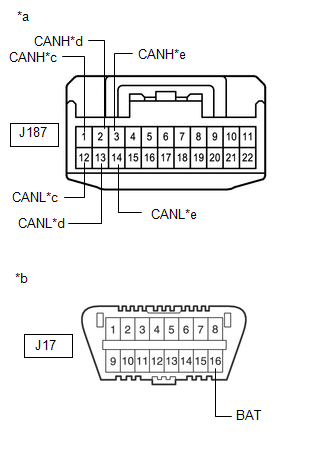 |
|
*a | Front view of wire harness connector
(to No. 2 CAN Junction Connector) | |
*b | Front view of DLC3 | |
*c | to No. 1 CAN Junction Connector | |
*d | to Forward Recognition Camera (w/ Pre-collision System) | |
*e | to Central Gateway ECU (Network Gateway ECU) | | |
(b) Measure the resistance according to the value(s) in the table below.
Standard Resistance: |
Tester Connection | Condition |
Specified Condition | Connected to |
|
*: w/ Pre-collision System
| | J187-1 (CANH) - J17-16 (BAT) |
Cable disconnected from negative (-) battery terminal |
6 kΩ or higher |
No. 1 CAN junction connector | |
J187-12 (CANL) - J17-16 (BAT) | |
J187-2 (CANH) - J17-16 (BAT) |
Cable disconnected from negative (-) battery terminal |
6 kΩ or higher |
Forward recognition camera* | |
J187-13 (CANL) - J17-16 (BAT) | |
J187-3 (CANH) - J17-16 (BAT) |
Cable disconnected from negative (-) battery terminal |
6 kΩ or higher |
Central gateway ECU (network gateway ECU) | |
J187-14 (CANL) - J17-16 (BAT) |
|
Result | Proceed to | |
OK | A | |
NG (No. 1 CAN junction connector CAN main wire) |
B | | NG (Central gateway ECU [network gateway ECU] CAN main wire) |
C | | NG (Wire to ECU or sensor) |
D |
| A |
 | REPLACE NO. 2 CAN JUNCTION CONNECTOR |
| B |
 | REPAIR OR REPLACE CAN MAIN WIRE OR CONNECTOR (NO. 2 CAN JUNCTION CONNECTOR - NO. 1 CAN JUNCTION CONNECTOR) |
| C |
 | GO TO STEP 8 |
|
D |
 | |
(a) Reconnect the J187 No. 2 CAN junction connector.
|
NEXT |
 | |
| 7. |
CHECK FOR SHORT TO B+ IN CAN BUS WIRE (CENTRAL GATEWAY ECU [NETWORK GATEWAY ECU] - NO. 2 CAN JUNCTION CONNECTOR) |
| (a) Disconnect the central gateway ECU (network gateway ECU) connector. |
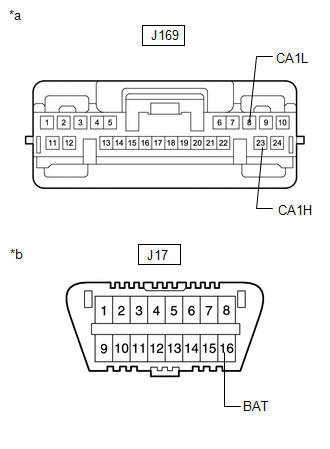 |
|
*a | Front view of wire harness connector
(to Central Gateway ECU [Network Gateway ECU]) | |
*b | Front view of DLC3 | | |
(b) Measure the resistance according to the value(s) in the table below.
Standard Resistance: |
Tester Connection | Condition |
Specified Condition | |
J169-23 (CA1H) - J17-16 (BAT) |
Cable disconnected from negative (-) battery terminal |
6 kΩ or higher | |
J169-8 (CA1L) - J17-16 (BAT) |
| OK |
 | REPLACE CENTRAL GATEWAY ECU (NETWORK GATEWAY ECU) |
| NG |
 | REPAIR OR REPLACE CAN MAIN WIRE OR CONNECTOR (CENTRAL GATEWAY ECU [NETWORK GATEWAY ECU] - NO. 2 CAN JUNCTION CONNECTOR) |
| 8. |
CHECK FOR SHORT TO B+ IN CAN BUS WIRE (ECU, SENSOR) |
| (a) Reconnect all wire harness connectors. |
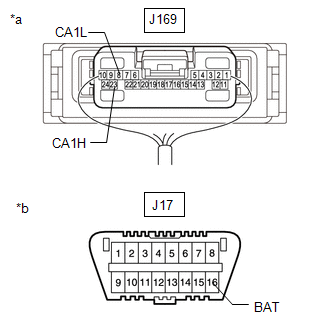 |
|
*a | Component with harness connected
(Central Gateway ECU [Network Gateway ECU]) | |
*b | Front view of DLC3 | | |
(b)
Disconnect the connector that includes terminals CANH and CANL from the
ECU or sensor to which the bus line shorted to +B is connected. Click here
 (c) Measure the resistance according to the value(s) in the table below.
Standard Resistance: |
Tester Connection | Condition |
Specified Condition | |
J169-23 (CA1H) - J17-16 (BAT) |
Cable disconnected from negative (-) battery terminal |
6 kΩ or higher | |
J169-8 (CA1L) - J17-16 (BAT) |
HINT:
- If the resistance changes to 6 kΩ or higher when the connector is
disconnected from the ECU or sensor, there may be a short in the ECU or
sensor.
- If the resistance does not become normal when the connector is
disconnected from the ECU or sensor, check for a short to +B in the wire
harness and repair or replace the wire harness or connector if
necessary.
| OK |
 | REPLACE ECU OR SENSOR |
| NG |
 | REPAIR OR REPLACE HARNESS OR CONNECTOR | |
